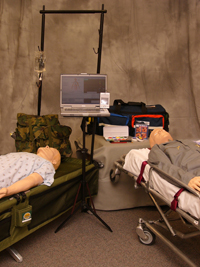 |
Shown here are simulators used to teach students to recognize smallpox, anthrax and avian flu, along with other equipment used to train students. |
The Web site is part of a University of Nebraska Programs of Excellence small project grant awarded to the UNMC College of Nursing. The grant team, led by Carol Pullen, Ed.D., UNMC College of Nursing, includes the School of Allied Health Professions and the Center for Biopreparedness Education.
The goal is to create simulations for students to develop critical thinking about how to respond to bioterrorism events, project coordinator Beth Beam said.
In the first phase of the grant, the team developed a Web site called Healthcare and Emergency Responder Organization Education through Simulation (HEROES). The www.onlineheroes.org site is tailored to the health care community, but anyone, including first responders, is welcome to use it. The site is still under development and feedback is welcome.
Using the Internet in addition to traditional approaches aids in instruction and enables an unlimited number of students and others to learn in a safe environment, Dr. Pullen said.
“We’re working with faculty to fit the content into courses,” Dr. Pullen said. “Simulation experiences provide a vehicle for student learning in a safe and controlled environment. People learn better by doing and there are not many opportunities to get this experience. This will help people prepare for bioterrorism events or public health emergencies.”
The Web site contains presentations, which include short videos and games, as well as other resources. The videos require a current version of Adobe Flash Media Player.
Some of the topics include mental health in disaster, fast acting chemical agents, the difference between small pox and chicken pox, how to properly dress in personal and protective equipment and how to administer treatment for nerve agents.
UNMC users, once registered on the site, can use their Lotus Notes identification and password for access. Other users will be prompted to create an ID and password once they receive registration confirmation.
A mannequin is used with other tools to teach students to recognize smallpox, anthrax and avian flu, Beam said.
“Simulation gives students a more realistic sense of what it may be like in these situations rather than just hearing a lecture about it. It enhances learning. Getting health professionals educated in these issues is a huge task,” she said.
Users can test their knowledge in the Web site’s games section. The virtual patients display vital signs and can be triaged and treated. One exercise puts the user in a “hot zone” where patients are contaminated with a nerve agent.
The site’s resources section contains information on isolation and quarantine, hazardous materials, chemical exposure, emergency preparedness, nuclear and radiological terrorism and response to mass casualties.
Additional phases of the grant are in development to explore other ways to educate health professionals and students in responding to bioterrorism and public health emergencies.
Collaborators include Patricia Carstens, UNMC College of Nursing, Philip Smith, M.D., medical director of the Center for Biopreparedness Education, Phyllis Muellenberg, School of Allied Health Professions and Sharon Medcalf, director of the Center for Biopreparedness Education.
For more information, contact Beth Beam, 559-6547.